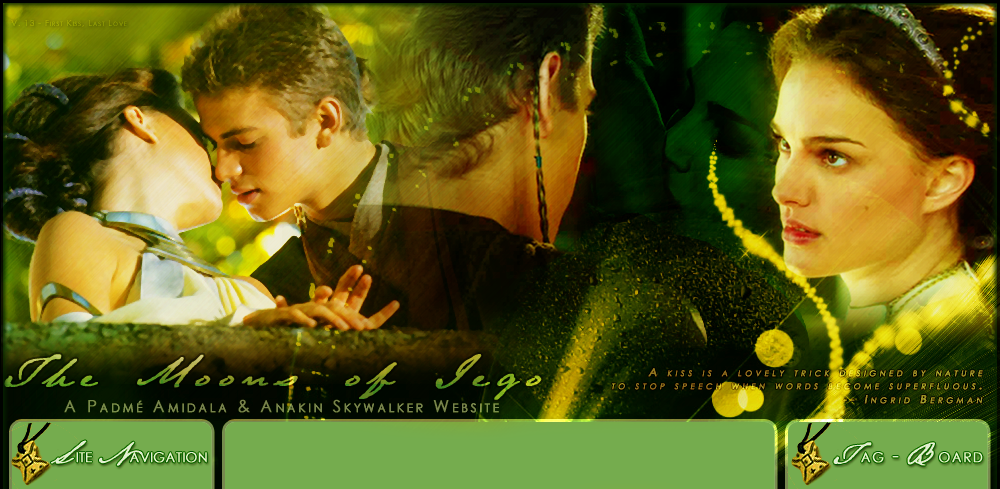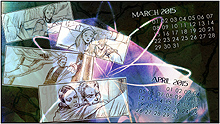



IMAGE |
WALLPAPER |
FAN ART |
FAN FICTION |
Rush by Love and Rock Music. (TCW) The first half of "Destroy Malevolence," as Anakin and Padmé make their way towards each other. |
P/A SITE
|
|
CALENDAR
|
 |

ESSAYS & DISCUSSION
-------------------------------------------
Fire and Water: Anakin and Padmé
by lazypadawan
------------------------------
Of all of the archetypal qualities of the various Star Wars characters, one of the most interesting involves the tragic love affair between Anakin Skywalker and Padmé Amidala. As male and female, they fit the anima (the feminine) and animus (the masculine) dichotomy. But, one could make the observation that they are also linked symbolically to opposing natural elements: fire and water. Together, they bring harmony to one another, but as events of the Star Wars saga show, it is difficult to keep a fiery spirit contained.
Anakin Skywalker is often visually associated with fire. In The Phantom Menace, we discover his origins on Tatooine, a hot desert planet scorched by two suns. As his story progresses, fire is often present at life-changing moments: when Anakin learns at Qui-Gon's cremation that he's going to be trained by Obi-Wan, when Anakin confesses his love for Padmé in a room lit only by a fireplace, when Shmi dies and Anakin takes his first step toward the Dark Side at the Sand People's fire-lit camp, and of course, when he completes his transformation into Darth Vader on fiery Mustafar. When Anakin is later redeemed and dies in Return of the Jedi, the remainder of his body is burnt in a pyre on Endor.
Padmé Amidala is just as often associated with water. Her homeworld Naboo is full of deep oceans, swamps, lakes, rivers, and waterfalls. Padmé's association with water is not particularly obvious in The Phantom Menace, save for the watery locations shown in the film. But in Attack of the Clones, the association with water is much more apparent. It is interesting to note that many of her costumes in that film are in some shade of blue. Even some of the gowns that she wears that are different colors seem to have some quality evocative of sunlight on the water, such as the so-called "rainbow" dress she wears when she and Anakin arrive at the Varykino retreat. Even her apartment on Coruscant has blue walls. She looks to the remote lake country of Naboo as her shelter, safe from those who wish to harm her and eventually, a safe place to carry out a clandestine love affair. One of her happy childhood memories there is swimming in the lake. As if to drive the point home, she tells Anakin, "I love the water" as they look out on the lake.
Even when Padmé dies, she is still symbolized by water. "She (costume designer Trisha Biggar)... explained that the color -- this beautiful azure blue -- and the rippled fabric matched the ethereal and melancholy landscape of the Naboo lake retreat at Lake Como... this is where Padmé had wanted to escape with Anakin, and the funeral gown symbolizes her spiritual return to that lake."1
Fire and water represent similar things among Eastern and Eastern-influenced schools of thought. Feng shui regards the element of fire as active, strong, impulsive, and attractive.2 Many would associate those qualities with Anakin. The young Jedi is quick to act in every situation, almost too quick at times. Since he is the Chosen One, the Force is naturally strong in him, making him quite powerful at a young age. Feng shui regards the element of water as flowing, travelling, learning, communicating, and influencing others.3 Padmé -- former ruler, Senator, and diplomat-- would share many of those qualities as well.
Modern neo-paganism takes a similar view of fire and water, perhaps influenced by Eastern religion. In Wicca, "fire is a purifying, masculine energy...connected with strong will and energy." There is also an association of fire with fertility.4 It is fitting then that fire is associated with the male half of the romantic couple. Given that one of Anakin's important contributions is fathering another generation of heroes, the association with fertility is appropriate as well. "Water is a feminine energy and highly connected with the aspects of the Goddess." It is also used for "healing, cleansing, and purification."5 As not only Anakin's partner but also as the prequel trilogy's main female character, Padmé certainly represents the anima, the feminine energy.
What happens when these energies are combined? In Taoism, fire and water symbolize "deeper sides of our nature."6 The fire is passionate and volatile, the water is calm, centered, soft, and flexible. "Using the more contained and settled 'water' side is using thoughtfulness, logic, and control to nurture and guide our more impulsive and wild side."7 While water is potentially destructive, most of the watery locations on Naboo are peaceful, as opposed to the stormy seas of Kamino. This aspect of water better reflects Padmé's personality, even though she is not always serene, nor is she passive. After all, water has currents and its own energy. In the films, Anakin frequently looks to Padmé to comfort him, guide him, and nurture him, whether it's when he's a young boy leaving home for the first time or confiding in her his troubling visions or frustrations. Padmé is usually able to diffuse his temper in a way few other characters can. When Anakin expresses his frustrations with Obi-Wan in Attack of the Clones, Padmé gently reminds him mentors had a way of seeing our mistakes and that is how we grow. When he is upset that Padmé and Queen Jamillia are discussing without his input where to find safety on Naboo, she calms him down and miraculously puts him in his place without upsetting him further. As Anakin tells her later on in the film, "Your presence is soothing." When Anakin is calm, he is able to act and use his abilities in a constructive way.
Conversely, "using... the excitable and temperamental 'fire' nature, to complete and balance the often too staid and overly controlling 'water' nature, is allowing that side of our character expression."8 It is clear Padmé is drawn to Anakin's passionate personality, bringing out her own fire in the process. He promises excitement and a life beyond responsibility and duty. He makes her laugh. He allows her to express the real person behind the political persona. The exchange between them during the Geonosis battle ("You call this a diplomatic solution?/"No, I call it aggressive negotiations") with a gleam in their eyes is reveals the exhilaration they feel by being together in a dangerous situation. Padmé generally abhors violence and even when she is pressed into action, she's usually all business. This is the first and only time she ever seems to enjoy fighting. Anakin brought out the happy warrior in Padmé.
"By finding a balance between these two sides of our makeup, we become more complete and whole."9 The wedding scene at the end of Attack of the Clones symbolizes the union between fire and water: during the ceremony, the setting sun blazes brightly over the lake. Anakin and Padmé feel complete and whole when they are together. One could argue that it is when they are out of balance is when things go wrong. Anakin's nightmares in Revenge of the Sith drive him to take matters into his own hands, disregarding Padmé's counsel, even her values, when he turns to evil in a misguided attempt to save her. Padmé is isolated from her homeworld and vulnerable as a mother-to-be forced to hide her pregnancy, so she is cut off from the source of her spiritual energy. The fires of Mustafar are a metaphor for how Anakin's passions are so out of control, Padmé's water spirit is no match for them. Her pleas for Anakin to reject the Dark Side and leave Mustafar with her fail to persuade him. When he believes Padmé has betrayed him, he strangles her, an act that ultimately leads to her demise. Anakin's out-of-control passions literally consume him and all but destroys his body after his duel with Obi-Wan. Padmé, broken-hearted, retreats into herself and "drowns." Describing the dress she wears in Padmé's funeral scene in Revenge of the Sith, Natalie Portman said, "Someone said to me it was very Ophelia. With the flowers and the hair, it does look like I'm drowning."10 Ultimately Padmé's body is returned to her homeworld, the river in the background as her funeral procession moves through the streets of Theed.
Fire can bring warmth and light, as Anakin's potential could have (and eventually) brought light to the galaxy, and as Padmé found true love with him. But fire can also destroy, as Anakin's powerful emotions spun out of control, losing everything he sought to save in the process. One would hope that a redeemed Anakin could be reunited with Padmé. Regardless, their legacies lie with their children, Luke and Leia, who as their children may represent a physical manifestation of that balance between the elements of fire and water.
Footnotes:
1. Biggar, Trisha. Dressing A Galaxy: The Costumes of Star Wars. Abrams. 2005, pg. 200
2. www.chartplanet.com/html/feng-shui.html
3. www.chartplanet.com/html/feng-shui.html
4. "The Four Classical Elements," Wigington, Patti. http://paganwiccan.about.com/od/wiccaandpaganismbasics/a/elements.htm
5. Wigington, Patti.
6. "Symbolic Language of Taoist Alchemy, " Ford, Chaddis. http://www.deeptrancenow.com/
7. Ford, Chaddis.
8. Ford, Chaddis.
9. Ford, Chaddis.
10. Biggar, Trisha.
-
<<back to essays & discussion